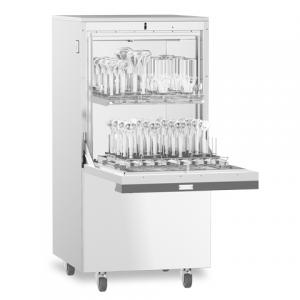laboratory glassware washer:Calibration method for ultraviolet visible spectrophotometer instruments
The calibration method for UV visible spectrophotometers refers to JJG178-2007 "Verification Regulations for UV Visible and Near Infrared Spectrophotometers".Requirements for the main performance indicators of UV visible spectrophotometers
Refer to the calibration regulations and instrument manuals to check the key indicators of the spectrophotometer during the calibration cycle to ensure normal instrument performance. At present, the JJG178 calibration regulation has different requirements for the technical specifications of ultraviolet and visible spectrophotometers in different wavelength ranges, namely the ultraviolet wavelength range A and visible wavelength range B, and the instrument is divided into four levels from high to low according to performance indicators: I, II, III, and IV. The following table shows the requirements for the main performance indicators of Class I spectrophotometers (see relevant calibration regulations for performance indicators of other grade instruments).
Calibration method for UV visible spectrophotometers
The calibration of UV and visible spectrophotometers is mainly carried out by testing some numerical technical indicators. For example, wavelength accuracy, wavelength repeatability, spectral bandwidth, stray light, resolution, transmittance error, transmittance specific gravity repeatability, noise, baseline flatness, etc., as the testing methods for technical indicators have already been introduced, this section mainly introduces the specific instrument conditions or calibration steps for calibrating wavelength accuracy and wavelength repeatability, transmittance accuracy and transmittance repeatability.
1. Wavelength accuracy and wavelength repeatability of UV visible spectrophotometers
If the instrument can accommodate a low-pressure mercury lamp, perform a full wavelength test using a low-pressure mercury lamp according to the calibration regulations. Otherwise, the instrument's inherent deuterium lamp can be used for testing. Take a single beam energy method with a scanning speed of 15nm/min, fast response, minimum bandwidth of 0.1nm, and range of 0-100%. Repeat the scanning three times in a single direction for the two single peaks of 486.02nm and 656.10nm, and measure the wavelengths of the two spectral lines on the spectrum. The difference between the average value of the wavelength measurement and the standard value of the wavelength is the wavelength accuracy, and the difference between the maximum and minimum values of the measured wavelength is the wavelength repeatability.
2. Ultraviolet visible spectrophotometer transmittance accuracy and transmittance specific gravity reproducibility
Take a bandwidth of 2nm, use one set of standard quartz absorption cells to respectively fill blank solution and potassium dichromate standard solution with a mass fraction of 0.006000%. Measure the transmittance three times continuously at four wavelengths of 235nm, 257nm, 313nm, and 350nm, and compare it with the standard value attached in the calibration procedure. The difference between the average measurement value and the standard value is the accuracy of the transmittance, and the difference between the maximum and minimum measurement values is the reproducibility of the transmittance density.
Precautions for calibration of UV visible spectrophotometers
Before calibration, the instrument should be turned on and preheated for a sufficient time to stabilize before proceeding, usually at least 30 minutes later.
When using standard materials, attention must be paid to calibration under the reproduction conditions of the standard values (i.e. the usage conditions specified by the standard materials), otherwise incorrect calibration results may occur. For example, when using the standard solution of GBW (E) 130066 spectrophotometer for calibration, two conditions must be met: a. The spectral bandwidth of the calibrated instrument should be 2nm. If the spectral bandwidth of the instrument cannot be adjusted and is greater than 2nm, the value given by the standard solution is not applicable and a correction value should be used; b. The two quartz cuvettes used for calibration should have an inner diameter of (10 ± 0.2) mm and good pairing at 235nm, 257nm, 313nm, and 350nm in order to reproduce the standard values.
When using standard solutions for calibration, special attention must also be paid to the laboratory temperature during calibration measurements, as these standard substances have different transmittance standard values at different temperatures.
The standard materials used in the standard must be stored under the conditions specified in the instruction manual. For example, interference filters should be stored in a dry and clean environment to avoid surface contamination, moisture, glue opening, or mold. All reference materials should be used within the validity period indicated on the certificate.
The uncertainty of the selected neutral filter standard value must comply with the transmission standard. When calibrating, attention should be paid to the directionality of the standard filter of the UV visible spectrophotometer.
 English
English Chinese
Chinese


